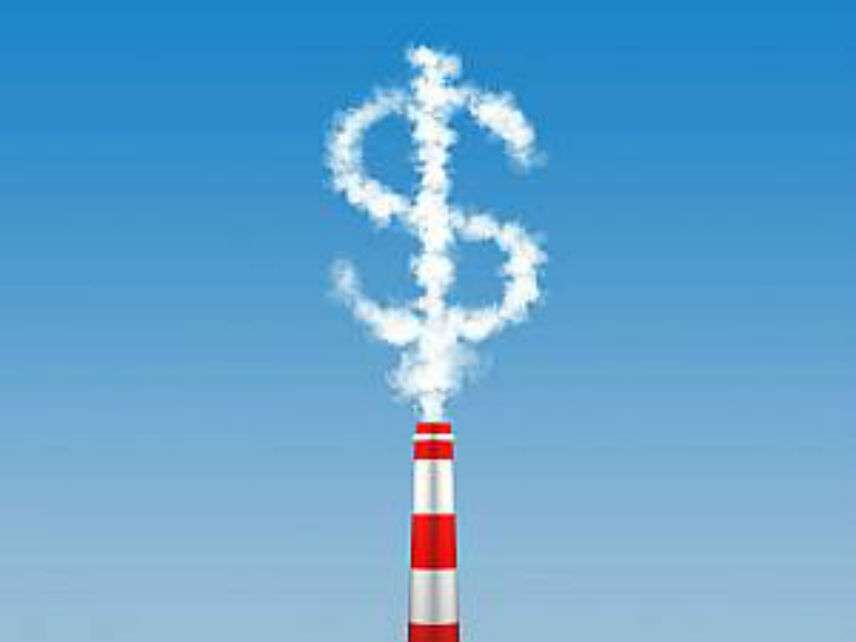Economists Love Carbon Taxes. Lots of Regular Folks Don't.
Raising the price of gasoline, heat, and electricity is a steep political hill to climb.

Oil company ConocoPhillips just pledged to spend $2 million promoting the carbon tax and dividend plan devised by the Climate Leadership Council (CLC) organized by former Republican Secretaries of State James Baker III and George Shultz. ConocoPhillips is among the CLC's founding member oil companies, alongside ExxonMobil, BP, and Shell.
The goal of the CLC's carbon tax and dividend plan is to reduce carbon dioxide emissions from fossil fuels by increasing fossil fuel prices over time. Under the CLC's carbon tax and dividend plan an initial tax per ton of carbon dioxide would be set at oil and gas wellheads and coal mineheads.
As the tax escalates at a steady predictable rate over the years, higher electricity and transport prices are supposed to encourage increased conservation, greater fuel efficiency, and the development and deployment of no-carbon energy sources. Once the CLC's carbon tax plan is adopted, all other regulations and subsidies aimed at reducing carbon dioxide emissions, e.g., automobile fuel efficiency and renewable portfolio standards, are supposed to be permanently repealed.
Finally, the linchpin of CLC's plan is that all of the proceeds from the carbon tax would be divided equally among U.S. citizens and returned as an annual lump-sum directly to them. The CLC argues that "conferring financial benefits in the here and now would fundamentally alter the cost-benefit time horizon of climate mitigation, re-casting a carbon fee as a popular and even populist solution."
The CLC cites a 2018 study that finds that 70 percent of American households would receive more in dividend payments than they would pay in increased energy prices. Taxpayers in the bottom income quintile would average a net tax cut of 4.4 percent of pretax income while those in the middle quintile would receive a net tax cut of 0.3 percent of pretax income.
While the concept of revenue neutral carbon taxes for addressing the problem of man-made climate change is beloved by most economists, the idea that they are "a popular and even populist solution" may be a bit premature.
The recent Yellow Vest protests in France were sparked by just a 12 cent increase in transport fuel taxes aimed at reducing that country's carbon dioxide emissions. (For the record, a gallon of gas already costs $5.54 in France.) The New York Times suggested that this outburst might have been avoided if the taxes had been specifically devoted to "subsidies to encourage people to use less-polluting forms of energy, and expanding transit networks."
Consider also what happened to carbon tax proposals in Washington state during the past couple of elections. In 2016, a revenue neutral carbon tax referendum failed when environmental activists opposed it on the grounds that the tax revenues should not be returned to voters, but instead be devoted to a panoply of green energy and public transit projects.
In 2018, Washington state voters rejected a carbon tax referendum crafted by environmental activists that would have created a kitty of new tax money available for politically favored groups to shower on their pet projects.
Australia adopted a carbon tax in 2012 that was repealed under popular pressure two years later.
Canada, meanwhile, has adopted a carbon tax scheme imposing a price of $20 per ton that applies to just four provinces (the others have set rates on carbon emissions that are already high enough to meet the new federal standards). Prime Minister Justin Trudeau has promised that 90 percent of the revenues collected will be rebated back to the residents of Saskatchewan, Manitoba, Ontario, and New Brunswick.
Despite the rebate pledge, Yellow Vest protests against the new Canadian carbon tax broke out this past weekend in some cities, including Edmonton, Toronto, Winnipeg, Okanagan, Moncton, Calgary, Saskatoon, and Halifax.
A 2018 World Bank report identifies 51 carbon pricing initiatives as having already been implemented or as scheduled for implementation. These consist of 25 emissions trading systems, mostly located in subnational jurisdictions, and 26 carbon taxes primarily implemented on a national level.
While carbon taxes make sense to economists worried about climate change, raising the price of staples like transport fuel, heat, and electricity remains a steep political hill to climb.
For folks who are worried about climate change, a more politically popular approach might be to incentivize a vigorous technology research and development program that aims at making low carbon energy cheaper than fossil fuels. In the meantime, encouraging economic growth will help to create the wealth needed to adopt low carbon technologies and adapt to whatever harms may emerge from man-made global warming.


Show Comments (49)